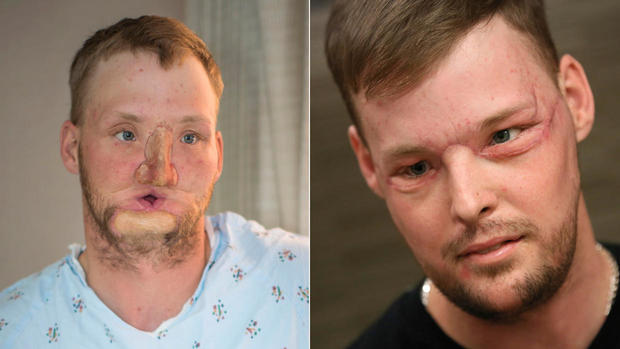Face transplant surgery: How are patients now?
(CBS) A new study offers a rare inside look at the three full face transplant procedures underwent at Brigham and Women's Hospital in Boston in 2011.
PICTURES: 7 Amazing face transplants (GRAPHIC IMAGES)
In March, surgeons at Brigham and Women's Hospital in Boston performed the first full face transplant in the U.S. on Dallas Wiens, a 26-year-old Texas man who accidentally struck a power line when painting a church. Less than a month later, BWH surgeons performed a full face transplant on 30-year-old Mitch Hunter of Indiana, who was disfigured after an auto accident (pictured). Then Charla Nash, who made headlines when her neighbor's chimpanzee mauled her in 2009, underwent the procedure at the hospital in May. All three are well on their way to recovery.
"Unlike conventional reconstruction, facial transplantation seeks to transform severely deformed features to a near-normal appearance and function that conventional reconstructive plastic surgical techniques cannot match," study author and lead surgeon Dr. Bohdan Pomahac, director of the plastic surgery transplantation program at BWH, said in a written statement. "It truly is a life-giving procedure for these patients."
In an effort to advance the face transplant field by sharing their findings, the surgeries are described in the Dec. 29 issue of the New England Journal of Medicine.
How did these amazing surgeries unfold? First, Pomahac and his team had to rigorously screen the prospective candidates with physicals and psychological exams to make sure they were mentally and physically prepared for the surgery.
The surgeons then describe in the journal how they worked with lots of hospital staff members and other clinicians so they could prepare the patient for transplant while simultaneously preparing the donor tissue, all within a short time frame.
Lastly, the doctors describe the patients' recovery, and how doctors had to constantly monitor the patients, adjusting their immunosuppressant medications so their bodies wouldn't reject the new faces. Both Hunter and Nash experienced a single episode of rejection each, and were treated with immunosuppressant drugs. All three patients got infections from the surgery, which were also treated.
Overall, the procedures were successful, and over time the transplanted tissue actually transformed and adapted to match features of each patient.
How are the patients doing now? Wiens' feeling in the right side of his face returned within four months. Hunter got feeling back in his chin, forehead, and lips within only three months. Nash currently has sensation in her face but no movement at this time.
"Our focus moving forward continues to be on monitoring and documenting the progress of patients who have undergone FFT, and refining the use of immunosuppressants, with the hope that one day patients will eventually need to take little or none," Pomahac said.
Since 2005, 18 patients have received face transplants with promising results, according to the study, but most have been to restore partial face defects.
Footage of Dallas Wien's surgery:
Surgery DW from BWH Public Affairs on Vimeo.


